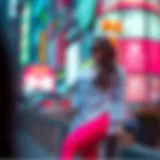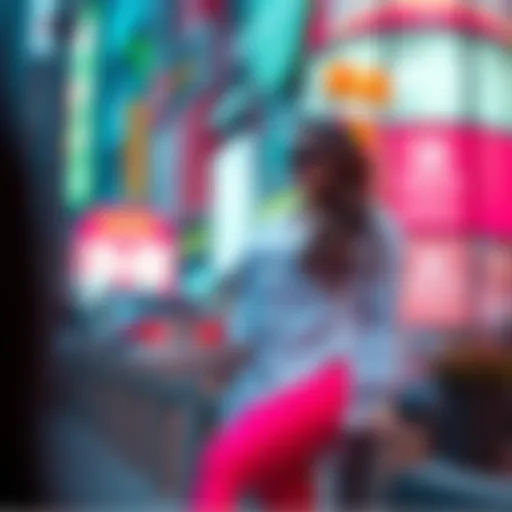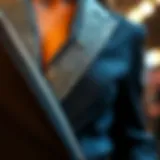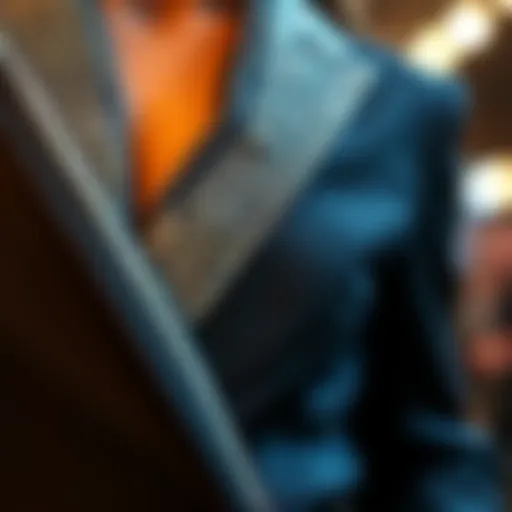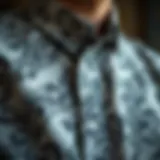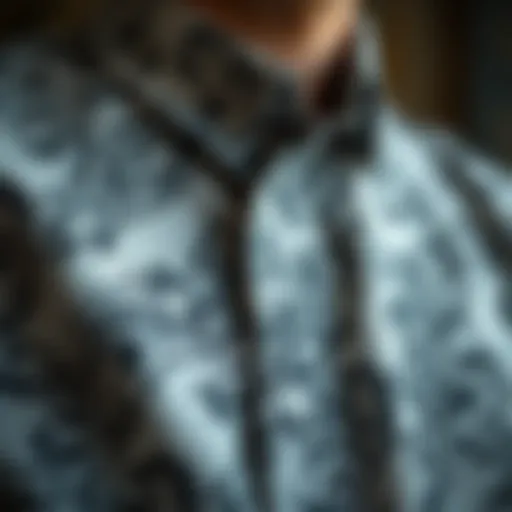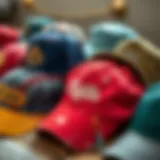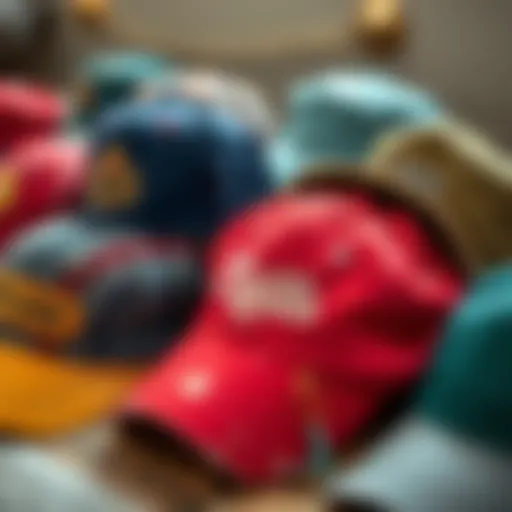Rediscovering 70s Inspired Pants: Style and Fabric


Intro
The resurgence of 70s inspired pants represents not just a flashback to a vibrant decade, but also a reinterpretation of style that is becoming more relevant in today's fashion dialogues. As fashion enthusiasts sift through fast trends and fleeting styles, there’s a growing longing for pieces that speak of history and personal expression. This exploration dives into the various styles and fabrics of the 70s, shedding light on how these can be seamlessly integrated into modern wardrobes while allowing individuals to reflect their unique tastes.
The nostalgia for the 70s is palpable. From flared silhouettes to bohemian prints, the era injected flair into everyday wear, and now, we’re seeing a renaissance of these bold choices in contemporary closets. As we navigate through design elements and historical contexts, this guide aims to provide insights not only on what styles reign supreme but also on the fabrics that elevate these pieces into the realm of high fashion.
In our journey, we will explore key components such as fabric knowledge and style tips that assist in pulling off these iconic looks with aplomb. So, for those ready to embrace flares, wide-legs, and everything in between, let’s get to the nitty-gritty of 70s inspired pants.
Historical Overview of 70s Fashion
The 1970s marked a vibrant period in fashion history, characterized by an eclectic mix of styles that reflected the social and cultural shifts of the time. This decade embraced both individuality and innovation, giving birth to trends that resonate even today. Understanding this historical overview is crucial for anyone exploring 70s inspired pants. Not only does it illuminate the roots of these unique styles, but also highlights how the choices of fabrics and silhouettes were significantly influenced by events and movements occurring both in the fashion world and society at large.
Fashion in the 70s was often seen as a canvas of self-expression. From the bohemian looks of the hippie movement to the polished glam of disco, there were few boundaries to style. Consequently, the pants of this era served as critical elements that helped paint this colorful picture. Various fabric choices — from denim to corduroy — along with silhouettes like flared and wide-leg cuts, became synonymous with the fashion ethos of the time.
Cultural Influences
The cultural landscape of the 1970s was a melting pot of influences that shaped not just music and art, but fashion too. Events such as the civil rights movement, the women's liberation movement, and the rise of counterculture all played a role in shaping personal style. For instance, the rise of feminism led women to embrace clothing that was not only fashionable but also practical. Pants became a symbol of freedom and rebellion against traditional gender norms. The introduction of the bell-bottom pant, with its flared legs, symbolized a departure from the conservative styles of previous decades.
Moreover, the music scene had a significant impact on fashion during this period. Icons such as David Bowie and bands like The Rolling Stones pushed boundaries not only in music but also in fashion. The rock 'n' roll aesthetic led to a bolder approach to fabrics and designs, with many opting for leather, bright prints, and daring cuts.
"Fashion is the armor to survive the reality of everyday life." – Bill Cunningham
Fashion Icons of the Era
Fashion icons of the 70s played a pivotal role in popularizing the trends that we now admire. Names like Twiggy, an iconic model with a fragile frame, showcased the new youthful spirit of the decade with her daring outfits that often included high-waisted bell-bottoms and platform shoes. Meanwhile, Farrah Fawcett and her famous hairstyle became synonymous with the glam look that many sought to emulate.
Another prominent figure was Jane Birkin, whose effortless combinations of loose tops and flared pants exuded a relaxed yet chic vibe. These celebrities helped cultivate a style that was both aspirational and approachable. Their influence transcended mere clothing; they set a tone for individualism and self-expression that became a hallmark of the 70s fashion landscape.
In short, the historical overview of 70s fashion paints a rich tapestry of influences that laid the groundwork for the resurgence of 70s inspired pants today. By understanding these elements, fashion enthusiasts can better appreciate how these pieces not only reflect a certain aesthetic but also carry the weight of cultural significance.
Defining Characteristics of 70s Pants
Understanding the specific traits that define 70s pants is crucial for anyone interested in integrating these unique garments into a modern wardrobe. The decade didn't simply dictate styles; it embraced a reinvention of fashion, where each cut and fabric screamed individuality and freedom. The design elements present in 70s pants are not just aesthetic choices; they are deeply rooted in cultural experiences of the time. By exploring these characteristics, one can appreciate not only how these pants can transform an outfit but also how they reflect historic trends and personal expression in today's fashion landscape.
Silhouette Variations
Flared Leg
The flared leg is perhaps the signature silhouette of 70s pants. This style gained immense popularity due to its distinct attitude—it symbolized a break from traditional fits. The key characteristic of flared pants is their tight fit around the thigh, widening dramatically at the knee down to the hem. This creates a beautiful hourglass shape, which exudes a balance of feminine grace and a touch of rebellious spirit.
Flared leg pants are often celebrated for their versatility. They can be paired with anything from fitted tops to flowing blouses, making them a favorable choice for both casual and formal occasions. However, one downside to this style is that it may not suit every body type; individuals with petite frames might find it overwhelming, as the exaggerated hem can dwarf proportions.
Wide Leg
Wide leg pants, on the other hand, offer a looser fit and an effortlessly chic flair. The defining aspect of wide leg trousers is the broad cut from waist to hem, which creates a relaxed silhouette. This style channels a laid-back vibe while remaining stylish, ideal for day-to-night transitions. The unique feature of wide leg pants lies in their comfort; they allow ample movement without compromising appearance.
Nevertheless, wide leg pants also come with their disadvantages. They can sometimes come across as overly casual, potentially making them less appropriate for formal settings. Additionally, pairing these with the right footwear is key; a poorly chosen shoe can throw off the whole look, hiding the intended elegance.
Tapered Styles
Tapered styles bring a different flavor to the party. These pants are fitted at the waist and thigh while narrowing down towards the ankle, creating a sleek line that elongates the leg. The defining characteristic of tapered pants is their structured look, making them a popular choice for those who prefer a more polished aesthetic.
Tapered styles are particularly beneficial as they are universally flattering, catering to various body shapes by capturing the natural curves without being overly restrictive. One might note, however, that tapered pants may limit movement slightly more than looser fits, which is a consideration to keep in mind when selecting for comfort versus style.
Fabric Choices
Different fabrics not only define the aesthetic of the pants but also influence their comfort level and practicality. The 70s saw an experimentation with textiles that added to the richness of the fashion scene.


Denim
Denim played a pivotal role in 70s pants, offering durability alongside stylish appeal. The rugged fabric became the backbone of casual wear and its contributing factor to the reverse of norms made it quite popular. Denim pants were a go-to choice as they could be dressed up or down with relative ease.
A unique quality of denim is its ability to age gracefully, developing a distinct patina over time which many wearers find desirable. However, some might argue that denim can be restrictive, especially in its stiffer forms. The ideal solution is to seek out those with a blend of elastane for added stretch and comfort, ensuring wearability alongside style.
Corduroy
Corduroy has an unmistakable texture that originated in England but was embraced wholeheartedly in the US during the 70s. This fabric is distinguished by its plush ribs, which add a touch of sophistication while providing warmth. Corduroy pants have the added benefit of being distinctively cozy, making them a popular fall and winter staple.
Their unique feature is versatility; they can be dressed up with a nice blazer or down with a casual tee. However, one consideration would be the maintenance; corduroy often requires careful cleaning to avoid crushing the fabric's texture, making it less ideal for everyday wear.
Polyester
Last but certainly not least, polyester became synonymous with 70s fashion. This synthetic fiber was celebrated for its affordability and ability to hold vibrant colors, making it a popular choice for various styles, including wide leg and flared pants. Polyesters durability contributed to its popularity, allowing clothes to retain their original shape and form beyond several washes.
While the sheen of polyester adds a touch of glam, the fabric's breathability may raise eyebrows. Some wearers find that polyester can feel less comfortable, especially in warmer weather, leading to an impactful shift toward natural fibers. Choosing blends or lightweight versions may help to address these wearability issues.
The Revival of 70s Inspired Pants
The revival of 70s inspired pants marks a significant turning point in today’s fashion landscape. As we navigate through an era marked by an eclectic mix of past influences, these trousers have clawed their way back to the forefront of style. This resurgence can be attributed to a confluence of cultural factors and a collective nostalgia for the vibrancy of that decade—one that is often characterized by both bold statements and distinct individuality.
In contemporary wardrobes, the appeal of 70s pants lies not only in their vintage charm but also in the multitude of styling options they offer. The flared and wide-leg designs have become synonymous with freedom of expression and comfort, making them a favorite for many fashion enthusiasts. Importantly, they present an opportunity to embrace unique silhouettes that diverge from today's more often skinny styles.
In simple terms, wearing these pants is like wearing a slice of history, one that encapsulates the essence of liberation, creativity, and experimentation in style, returning to shape our identities through fashion.
Contemporary Fashion Trends
The landscape of modern fashion thrives on reinvention, and few styles echo this sentiment quite like the 70s pant. Major brands and independent designers alike are tapping into the flair of this era, adopting its key elements and injecting a fresh spin at the same time. Today, you’ll find various interpretations of these pants—in collections that range from high street labels to upscale designers.
Fashion events and street style moments often showcase the adaptability of these pieces.
- Mix and Match: From pairing flared jeans with a tailored blazer for a chic office look to coupling wide-legs with a crop top for a night out, the combination possibilities are nearly endless.
- Layering: The 70s are also back in outerwear. Longline jackets, oversized cardigans, and colorful vests harmoniously pair with these unique trousers.
- Colors and Prints: Bright colors and funky prints, reminiscent of the psychedelic experience, are being utilized boldly, which enhances their distinctiveness and attracts attention.
This ability to adapt these pants reinforces their relevance in today’s confines of fashion, as they blend seamlessly into not just vintage styles, but also minimalistic and athleisure trends as well.
Influence of Sustainable Fashion
In the age of fast fashion and growing concerns related to environmental impact, the revival of 70s inspired pants also coincides with the rising emphasis on sustainability. Many consumers are now prioritizing quality over quantity, leading to a preference for pieces that include sustainable materials and ethical production processes.
- Recycled Fabrics: With advancements in fabric technology, brands are now focusing on reinventing materials like denim, turning recycled fibers into chic 70s-styled trousers that appeal to eco-conscious shoppers.
- Durability and Timelessness: The fundamental fit of 70s pants often tends to be durable, allowing them to last longer than more trend-driven pieces. Far from just a fleeting trend, these pants become staple items, which reduces the need for continuous purchasing.
- Secondhand and Vintage Market: Thrift shopping has surged in popularity, as individuals turn to secondhand stores to discover authentic 70s styles. Platforms like Depop or local thrift shops give a nostalgic charm while promoting recycling.
In summary, the resurgence of 70s inspired pants not only offers a stylish connection to the past but also aligns with contemporary values around sustainability and ethical fashion. The span this trend covers—from runway to street—illustrates a substantial movement that is set to continue in the coming years, reflecting both our fashion choices and our values.
Styling 70s Inspired Pants
The way we style 70s inspired pants holds great significance in contemporary fashion. These pieces are not merely a blast from the past; they represent a unique blending of nostalgia and modernity. Understanding how to style them can make a world of difference in making a fashion statement. These pants are versatile, offering various silhouettes and fabrics that can suit different occasions. Consequently, knowing how to match them with the right tops and footwear can enhance not only the overall look but also the comfort of the wearer.
Choosing the Right Top
When styling 70s inspired pants, the choice of top can either elevate the look or bring the entire outfit crashing down. It acts as the anchor, determining the direction of the ensemble.
Fitted Blouses
Fitted blouses are a fantastic option when it comes to styling 70s inspired pants. The primary characteristic of fitted blouses is their tailored nature, which contrasts nicely with the often relaxed fit of the pants. This combination creates a balanced silhouette that flatters various body types. A fitted blouse can draw attention to the waist, highlighting curves in a way that is both fashionable and flattering.
The advantage of fitted blouses is their ability to create a streamlined look. They allow for easy tucking into high-waisted pants, which was all the rage in the 70s. On the flip side, some may find these tops restrictive in terms of movement, especially if made from stiffer materials.
Boxy T-shirts


Boxy t-shirts present another appealing choice for pairing with 70s inspired pants. Their key characteristic is the unstructured shape that falls loosely, providing a casual and laid-back vibe. This style resonates well with the relaxed aesthetic often associated with the 70s. The unique feature of boxy t-shirts is their comfort and breathability, making them an ideal choice for warmer weather or casual outings.
While boxy t-shirts can effortlessly complement flared or wide-leg pants, they might not highlight the waist as effectively as fitted blouses do. However, their ease of wear and ability to create a relaxed style snatch them a prominent place in a modern wardrobe.
Footwear Considerations
Footwear serves as the final piece in the puzzle of styling 70s inspired pants. The right shoes can truly pull an outfit together, so it’s imperative to choose wisely.
Platforms
Platforms are an iconic choice to wear with 70s inspired pants. What sets platforms apart is their thick soles that add height without compromising comfort. They provide the needed leg elongation, which is crucial when pairing with wide-leg styles. The benefit of wearing platforms is that they can amplify one’s stature while still being easy on the feet. However, wearers should be cautious; not all platform styles pair seamlessly with every pant type, and sometimes a more delicate shoe can create balance.
Boots
Boots are another footwear option that can work wonders with 70s inspired pants. Their key characteristic is versatility; whether you opt for ankle or knee-high, they can suit both casual and more formal occasions. Boots lend an edge to the outfit, especially when styled with corduroy or denim pants.
One of the unique features of boots is their ability to add a certain ruggedness to an otherwise feminine outfit. However, the downside could be comfort; some styles might be stiff or constricting, making it essential to choose a pair that allows for all-day wear.
Overall, styling 70s inspired pants requires attention to both tops and footwear, ensuring that comfort is not sacrificed in the name of style. With the right combinations, these pants can make a powerful statement in any wardrobe.
Celebrity Endorsements and Influences
The sway of celebrities in the fashion world is hard to ignore. They wield a unique power to shape trends and amplify styles that might otherwise drift into obscurity. In the context of 70s inspired pants, this influence can be seen as both a revival and an endorsement of the aesthetic that marked the decade. These bold designs have found their way back into the limelight, often because beloved public figures have reintroduced them to contemporary sensibilities. Why does this matter? Simply put, when a prominent figure steps out in wide-leg corduroys or flared denims, the public takes notice, and that can ignite a newfound interest in not just the garment but the entire lifestyle it represents.
A big part of this phenomenon is the relational aspect of fashion: consumers often feel a connection with figures they admire. Those stars sporting 70s inspired styles act as trendsetters, creating a dialogue about the past that resonates with today's societal values of authenticity and self-expression. When people see their idols confidently flaunting these styles, it encourages them to embrace their own individuality through similar choices.
Prominent Figures Embracing the Style
Over the past few years, several influential figures have publicly championed the 70s aesthetic in their everyday wear. Start with names like Janelle Monáe, who has been known to don flared trousers paired with vibrant prints and accessories that echo the era. Her fashion choices challenge not just contemporary styles but also encourage fans to explore their roots. Then there's Harry Styles, whose eclectic wardrobe often melds vintage with modern flair, featuring high-waisted trousers reminiscent of the disco inferno days. Both figures do not just wear the style; they embody a spirit of exploration that invites others to do the same.
Additionally, influencers on platforms like Instagram continually shine a light on this trend. They often curate outfits that pay homage to the 70s by combining vintage pieces with modern elements, making it accessible for a younger audience who might not have experienced the era firsthand. These implementations inspire a new generation to reconsider the items in thrift stores, melding nostalgia with sustainable fashion practices.
Social Media and Fashion Trends
In today's digital age, social media serves as a launchpad for fashion trends, and the resurgence of 70s inspired pants has greatly benefitted from this. Platforms like Instagram and Pinterest are overflowing with visuals of how these pieces are styled in various contexts. The hashtags such as #70sFashion and #VintageVibes are more than just labels; they create communities. They foster dialogues that allow enthusiasts to swap styling tips or find inspiration for their outfits.
Moreover, platforms like TikTok have taken this to another level with trends going viral almost overnight. Just a quick search might reveal dance challenges paired with flaunting 70s inspired pants in various uploads. This immediacy and interactivity blend seamlessly with the fast-paced fashion world, bridging generational gaps and allowing for a more inclusive conversation about style choices.
Fashion is what you buy, but style is what you do with it—this simple truth is magnified when celebrities and social media combine their forces to bring vintage designs back into everyday wardrobes.
This confluence of celebrity endorsement and social media advocacy not only boosts sales for designers and retailers but also enriches the fashion landscape, making the 70s less a mere chapter in history and more a continuous source of inspiration and expression today.
Practical Guides for Buying 70s Inspired Pants
The resurgence of 70s inspired pants is more than just a passing fashion trend; it signals a deeper exploration into the cultural and aesthetic significance of the era's style. However, navigating the marketplace can be quite the challenge with the myriad of options available today. Therefore, having a practical guide for purchasing these vintage-inspired pants can alleviate some of that pressure. This guide will not only highlight essential elements to consider when buying but also illustrate how choosing the right piece can elevate personal style.
Understanding Fit and Comfort
When it comes to buying pants, fit and comfort go hand-in-hand like peanut butter and jelly. You might be drawn to a bright, flared pair, but if they don’t fit well, they’ll gather dust in your closet faster than you can say �‘fashion faux pas.’ Finding the right fit requires attention to several key factors.
- Body Shape Consideration: Everyone has a unique body shape, and understanding yours will guide you in selecting styles that enhance your silhouette rather than hinder it. Whether you're curvaceous or lean, some styles will flatter more than others. For example, wide-leg pants are a fantastic choice for those with an hourglass figure as they emphasize the waist while providing a relaxed fit.
- Size Variability: Sizing can be a minefield, especially since vintage styles tend to run differently than modern cuts. It's not uncommon for a size 10 in 1970s context to fit like a contemporary size 6. To sidestep the fit pitfalls, it's beneficial to try on various sizes and styles if shopping in person. If you're buying online, always refer to the specific brand’s sizing chart and consider reading customer reviews for fit feedback.
- Fabric Stretch: Some fabrics offer more give than others. If you find a pair you love but they feel a tad snug, consider options made from materials with spandex or elastane blended in; they typically offer a more forgiving fit. On the flip side, pure denim can stiffen up with wear, so think about how the fabric will adapt and age.
- Movement Freedom: Comfort largely hinges on how freely you can move. When trying on, perform a few squats or take a stride – if you feel constrained, they might not be the right fit. Aim for pants that don’t just look good but also allow you to live your life comfortably.
Price and Value Assessment
When searching for the perfect pair of 70s inspired pants, price can be a double-edged sword. It’s essential to truly assess not just the cost but the value that comes with it. The golden rule here is to consider the longevity of the piece alongside its price tag. Here are some key points to keep in mind:
- Craftsmanship Over Cost: High-quality materials result in a better long-term investment. Look for heavy-duty seams and well-constructed waistbands. Premium brands like Levi’s or vintage retailers often carry pieces that withstand the test of time, making the price more justifiable.
- Research Trends: Check what others are paying for similar styles. By scouting vintage shops and online platforms, you can gauge whether a particular price makes sense. Sites like eBay or Poshmark can provide insights into the market value of specific brands and styles.
- Emotional Connection: Does the piece resonate with your style or evoke feelings of nostalgia? If yes, it might be worth a splurge. Buying clothing that tells a story or connects with your personal aesthetic can yield greater satisfaction than clothes that serve merely functional purposes.
- Sustainability Factor: More consumers are now considering the environmental impact of their purchases. Investing in sustainable, ethically made pants may come with a higher upfront price but pay dividends in terms of wearability and reducing your carbon footprint.
- Sales Opportunities: Always keep an eye on sales, especially from well-known brands. Signing up for newsletters or following brands on social media can alert you to upcoming discounts, giving you a chance to snag your desired pair at a lower price.
"Investing in pieces that speak to you personally will often outweigh the price in terms of happiness and satisfaction."


The Intersection of Comfort and Style
The interplay between comfort and style is crucial in the world of fashion, particularly when discussing 70s inspired pants. The revival of this era's fashion allows wearers to express their individuality while ensuring that they are not sacrificing ease for aesthetics. In this section, we'll dissect how specific elements such as fabric choice, fit, and overall design impact not just the look, but the comfort of these iconic pants.
How Fabrics Affect Wearability
Fabric is the unsung hero of any outfit, determining not only the aesthetic but also the functionality of 70s inspired pants. When considering wearability, the choice of material is paramount. Denim, often associated with a casual vibe, brings a sturdy yet adaptable feel to flared or wide-leg designs. Not only does it hold shape well, but it also ages gracefully, developing a unique patina that adds character.
On the other hand, corduroy, with its distinct texture, elevates comfort through its soft and warm properties. It’s an ideal choice for cooler weather, providing a snug yet stylish option. The presence of polyester blends in many 70s inspired styles further enhances wearability, as these materials can offer stretch and breathability. Ultimately, selecting a fabric that aligns with personal comfort, while reflecting one’s style, is invaluable.
Adjustments for Different Body Types
Understanding how different designs fit various body types is essential in maximizing both comfort and style. Acknowledging individual shapes allows for the right adjustments in pants styling. For instance, high-waisted flared pants can enhance the silhouette of those with an hourglass figure, providing a flattering lift and elongation of the legs. Conversely, individuals with wider hips may find that choosing tapered styles balances their dimensions better, allowing for ease of movement without compromising on an appealing look.
Also, making sure the inseam is appropriate matters greatly. A too-long pant leg can lead to tripping hazards while a too-short one can ruin the entire outfit’s intention. Tailoring hems to the right length can be a game-changer, ensuring that comfort is prioritized without losing sight of visual impact.
"True style is not about what you wear but how you wear it; comfort and confidence go hand in hand."
By re-evaluating fit based on unique body types and preferences, wearers can fully embrace the spirit of 70s inspired pants while maintaining comfort. It’s all about finding that sweet spot where style and comfort converge.
Social Context and Fashion Statements
When we talk about the revival of 70s inspired pants, it’s not just about the fabric or the cut; it’s also about what these garments represent within societal trends. Fashion is a reflection of the times we live in, and the resurgence of these retro styles speaks volumes about the cultural landscape today. Vintage clothing often symbolizes a yearning for authenticity and rebellion against fast fashion. The current generations are gravitating towards more sustainable choices, and 70s inspired pants fit that bill nicely. They're not just articles of clothing, they're statements that assert individuality and environmental consciousness.
Fashion as Self-Expression
In this era where personal branding and self-expression are at the forefront, clothing choices like 70s inspired pants offer individuals a canvas to showcase their identity. This is particularly important in a world saturated with generic fashion options. Each pair of flared jeans or corduroy trousers tells a story about history, fashion evolution, and personal style. Different people interpret these styles in unique ways.
For instance, someone who chooses to wear high-waisted flares might do so not only because they are comfortable but also to signal a connection to nostalgia or a certain lifestyle. They might pair them with a vintage band tee or a chic blouse, creating a look that is distinctly their own. People may also use fashion to align with values or cultures, making their outfit choices more meaningful.
- Factors that contribute to self-expression in fashion include:
- Personal history associated with styles from the 70s.
- The social circles one navigates that may influence fashion choices.
- Political views that resonate with a vintage aesthetic, often perceived as counterculture or anti-establishment.
This relationship between clothing and identity isn't new; however, it has gained momentum with social media amplifying the reach of personal style, allowing trends to arise organically rather than being dictated from the top down.
Political and Social Reflections in Fashion
Fashion has long been a mirror reflecting the political climate. In the 1970s, pants styles echoed societal shifts—from the civil rights movement to the feminist push for equality. Today, the return of these styles invites a fresh discourse on political and social matters. Wearing 70s inspired pants is sometimes a statement beyond aesthetics. It can reflect one's stance on sustainability, gender, and cultural identity.
"Fashion might not change the world, but it profoundly connects us to it.”
Moreover, brands focusing on eco-friendly manufacturing processes and ethical labor practices can have a strong appeal. Today's consumers often think twice about what they wear, aware that each piece can symbolize their values and beliefs. It's not just about what looks good anymore, but what feels right.
Things to consider when examining the political statement behind fashion include:
- The brand's commitment to ethical production.
- Styles that particularly resonate with modern movements (like high-waisted pants linking back to body positivity).
- Changing narratives around masculinity and femininity as dress codes evolve.
Future Trends for 70s Inspired Pants
The fascination with 70s inspired pants extends beyond mere nostalgia. As fashion continues to cycle through decades, the focus on this era signifies a deeper connection with self-expression and craftsmanship. In this final section, we will explore what lies ahead for these trousers, scrutinizing predictions for the upcoming seasons and the potential innovations in fabric technology that might redefine them.
Predictions for Upcoming Seasons
As we look at the horizon of fashion, we can expect 70s inspired pants to evolve in several directions. The demand for sustainability is becoming paramount, so brands are likely to adjust their production strategies accordingly. Here are a few anticipated trends:
- Retro Fit: Expect to see a resurgence of authentic fits from the 70s. Flared legs and wide silhouettes could get modern tweaks to suit contemporary tastes while retaining their vintage vibe.
- Versatile Cuts: Designers might explore more hybrid styles that blend the 70s aesthetic with modern streetwear. Think pants that easily transition between casual outings and more polished events.
- Color Play: Retro earth tones like olive green, burnt orange, and rust will take the stage, but don’t discount bright colors and patterns. 70s graphics and prints can easily find their way into future designs, offering a nod to the past.
As these styles gain traction, retailers will adapt to meet the needs of a diverse consumer base. The evolution in silhouette and pattern will play a major role in engaging both new and seasoned fashion enthusiasts.
Potential Innovations in Fabric Technology
The advancement in fabric technology stands to greatly impact the future of 70s inspired pants. As we push further into the future, various innovations promise not just aesthetic appeal but also comfort and durability. Let’s break down a couple of noteworthy advancements:
- Eco-Friendly Materials: Innovations in organic cotton, bamboo fibers, and recycled materials could drive the industry toward more ethical practices. Expect brands to step up by incorporating these sustainable options into their retro designs.
- Tech-Enhanced Fabrics: Fabrics that offer moisture-wicking properties and elasticity without losing their vintage charm might surface. This would mean comfortable wearability while embracing the iconic styles of the 70s.
- Smart Textiles: Imagine pants that adjust to temperature or provide support where needed. As technology accelerates, the possibility of integrating smart elements into everyday fashion might just find its way into 70s-inspired apparel.
Fashion is always evolving, and as we look towards the future, the influence of past styles continues to ignite creative sparks in designers and consumers alike. With innovative technologies and sustainable practices in play, 70s inspired pants are set to navigate through fashion's new terrains with flair and vitality.
